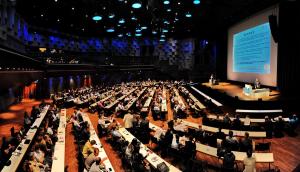Positive results with new wall materials at PSI 2012
15 Jun 2012
-
Steve Lisgo, ITER Organization
Approximately 400 people from all of the ITER Member countries came to the historic city of Aachen, Germany, to attend the 2012 Plasma-Surface Interactions (PSI) conference.
From May 21-25, a very successful Plasma-Surface Interactions (PSI) conference was held in the historic city of Aachen, Germany, which houses Roman baths and is known as "The Emperor's City" due to its status as Charlemagne's favourite place of residence.
The conference, which is held every two years, focuses on the region of the fusion plasma that is closest to the inner wall of the containment vessel, exploring both how the wall is affected and how the plasma responds to the release of wall material. Approximately 400 people came from all of the ITER Member countries, with the number of participants quadrupling since 1980, reflecting the importance of plasma-surface effects in high-performance devices like ITER and fusion power stations.
ITER is considering changing the wall material from carbon to tungsten for the areas that receive the highest heat loads. The conference was very timely in that many of the presentations discussed the properties of tungsten, from melting and gas trapping to less familiar effects caused by plasma exposure such as the formation of bubbles and nanostructures on the surface.
Of particular note was the presentation of initial experimental results from the ITER-like wall that was recently installed in the JET tokamak. The wall tiles are made from tungsten and beryllium, and are arranged in a way that is similar to the ITER design. There was quite a bit of good news, including fuel retention levels consistent with the ITER requirements and the production of clean, high performance plasmas.
Other topics covered included heat load control, plasma transport, and computer simulations, as well as a look to the future with respect to advanced wall materials, novel magnetic field designs, and reactor requirements.
The final presentation was a lively retrospective by Volker Philipps from Forschungszentrum Jülich that celebrated the 40-year history of the conference and highlighted progress that has been made in the field. The conference location moves between North America, Europe, and Asia; Kanazawa, Japan was announced as the next host city.


